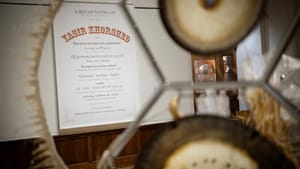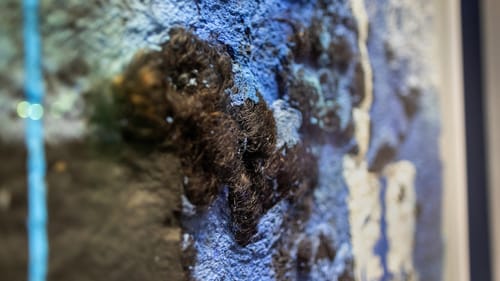Stay in the Loop
BSR publishes on a weekly schedule, with an email newsletter every Wednesday and Thursday morning. There’s no paywall, and subscribing is always free.
How do we remember?
Arthur Ross Gallery presents Songs for Ritual and Remembrance

Memory is an amalgam of what we know, believe, and imagine. It’s a shape-shifter, vulnerable to bias and emotion. It can fade over time, only to be perfectly reconstituted by a scent or sound. In Songs for Ritual and Remembrance at the University of Pennsylvania’s Arthur Ross Gallery, four artists consider what shared memory signifies for marginalized peoples and how they preserve it.
Honoring overlooked lives
Ken Lum remembers people who never were. An artist, writer, and fine arts chair of UPenn’s School of Design, Lum’s practice challenges accepted perspectives. He’s created and consulted on numerous public art projects, including co-curating Philadelphia’s 2017 citywide exhibition Monument Lab.
In the series Necrology (2017-present), Lum spins fact and fiction into wistful obituaries for imaginary decedents who stand in for real people whose lives passed without note. With phrasing and design inspired by 19th-century print communication, the death notices present tragic news in a strangely celebratory way.
In the billboard-sized example on view, we read of Yasir Khorshed, a garment worker whose name is rendered in a large red curve of Caliope Victorian type, a headline P.T. Barnum might have designed. We learn “the means by which he acquired his courage and wisdom,” of his “untiring fight” against “the iniquity of sweatshop conditions,” and how he died “at the age of thirty-four” from “cancer due to benzene exposure.” A sign in the gallery informs us that Lum’s mother, a garment worker, lost her life to benzene-induced leukemia.
The fabric of labor
Khorshed has much in common with Mary Ann Peters’s “factory girls,” 19th-century Syrian silk spinners memorialized in work commissioned for this exhibit. The women, who successfully negotiated better pay and conditions from the French government, are remembered in Peters’s multi-panel storyboard (Mt. Lebanon, double take, the factory girls) (2023) and adjacent installation the threads that bind (2023). Threads is part of the artist’s impossible monuments series, elevating people unlikely to receive actual statues or tablets.
The most evocative of storyboard’s ink-and-watercolor panels depicts a line of women leaning over worktables before an enormous wall of equipment, as though part of the machinery. They wear headscarves, their backs are turned, and as the figures stretch toward the vanishing point, they lose human form, becoming sepia splotches that might as easily be a row of cows, waiting to be milked.
In threads, Peters places a tall spindle of colorful strands in front of a tarlatan (stiffened muslin) backdrop that turns into shining fabric as it descends to the floor. Embedded in the weave are whispers of names: Shafika, Azlezah, Yasmine, Jalileh, Fatima, and Violet. In a note to curator and Arthur Ross assistant director Emily Zimmerman, Peters explained, “Using tarlatan as a scrim has metaphorical associations with the screening of conditions of factory work and the value of labor.”
A healing journey
Guadalupe Maravilla knows what it is to be a refugee. At eight, he was an undocumented, unaccompanied child migrating to the United States from El Salvador. His two-and-a-half-month journey walking through Honduras, Guatemala, and Mexico in 1984 reunited him with his family.
Maravilla also understands illness. A decade ago, diagnosed with cancer, the artist submitted to every available form of healing, from traditional medicine to the practices of healers, witches, and shamans.
Disease Thrower #16 (2021), one of a series, is his response to the harrowing life experience. The six-foot sculpture is made of glass dishes, loofah sponges, shining metal gongs, and objects Maravilla collected when he retraced his journey north. In addition to focusing and quieting the mind, he uses the pieces in therapeutic performances. “They’re headdresses, they’re shrines, and they’re healing instruments,” Maravilla explained in an Art 21 profile in which he demonstrated a restorative “sound bath” of ethereal, soothing tones by striking the gongs and other instruments with felt-tipped mallets. As part of his practice, he works with aid organizations, offering workshops for today’s migrants. “Now that I’ve learned to heal myself,” he said, “I have to teach others.”
Memories, from the ground up
Though sound is integral to Maravilla, gongs are not what resonates through the gallery. Instead, we hear a spiritual: “Sit Down Servant, Rest a Little While,” leading to the work of Adebunmi Gbadebo. The hymn accompanies a pair of weathered Pews (1890), salvaged by Gbadebo from Old Jerusalem Church, on South Carolina’s True Blue Plantation. Her ancestors worked the plantation and built these pews, and the unseen congregation is her family, singing a relative to their final rest.
Pieces by Gbadebo, which compose half of Ritual and Remembrance, dig deeply into heritage. As a resident artist at Philadelphia’s Clay Studio, she works on Land for Sale, a series exploring True Blue Plantation. Production 5 (2022), the large collage that opens the exhibition, is a striking work composed of elements connected to True Blue. Rice is in the paper, indigo provided the dye, printed photographs carry scenes of the fields and mills where her people labored. Giving the piece dimension are tufts of cotton and Black hair, which Gbadebo often incorporates into her work.

From the soil of True Blue Cemetery, Gbadebo crafted In Memory of K Smalls died 19?? HFS (2021), a red clay vessel studded with grains of Carolina Gold rice, a crop her ancestors harvested. It was, she said, “a way to commemorate what they endured and a way to activate the land, using it and shaping it. The making of the work has been a practice of healing and a practice of care for their memories; and what remains of their physical bodies, it’s in the soil.”
We carry memory with us, preserving, sharing, editing as we go. And, sometimes, encountering people who recollect different things, or recollect differently, we amend what we know, believe, and imagine. We make room for memories beyond our own.
What, When, Where
Songs for Ritual and Remembrance. Through September 17, 2023, at Arthur Ross Gallery, University of Pennsylvania, Fisher Fine Arts Library Building, 220 South 34th Street, Philadelphia. (215) 898-2083 or arthurrossgallery.org.
Accessibility
The wheelchair-accessible entrance to Arthur Ross Gallery and Fisher Fine Arts Library is through the Duhring Wing, on the building’s south side opposite Irvine Auditorium. To access the entrance, call (215) 898-2083 in advance, or (215) 898-1479 (guard’s desk) when on site.
Sign up for our newsletter
All of the week's new articles, all in one place. Sign up for the free weekly BSR newsletters, and don't miss a conversation.
